Potential Output: Concepts and Measurement - Department of Labour
Potential Output: Concepts and Measurement - Department of Labour
Potential Output: Concepts and Measurement - Department of Labour
Create successful ePaper yourself
Turn your PDF publications into a flip-book with our unique Google optimized e-Paper software.
Darren Gibbs 97<br />
force participation rates was replaced with a series in which all observations<br />
were equal to the average rate <strong>of</strong> participation over the sample period; the actual<br />
series <strong>of</strong> employment rates was replaced with the estimated ‘natural’ employment<br />
rates derived earlier in this section; the actual series <strong>of</strong> hours worked per<br />
employee was replaced with a series in which all observations were equal to the<br />
average hours per employee over the sample period; <strong>and</strong> the actual series <strong>of</strong><br />
capacity utilisation was replaced by a series in which all observations were equal<br />
to the average rate <strong>of</strong> capacity utilisation over the sample period. 14 The influence<br />
<strong>of</strong> technology was proxied as is st<strong>and</strong>ard in these techniques by adding back the<br />
residuals to the above predicted values.<br />
Figure 5 illustrates the estimated potential output series <strong>and</strong> the estimated<br />
output gaps obtained by following the above approach.<br />
As Figure 5 illustrates, the output gap derived from the production function<br />
based estimate <strong>of</strong> potential output is similar to the others derived so far. The mid<br />
1980s is identified as a period in which output was above potential, while the<br />
early 1990s is identified as a period during which output was well below potential.<br />
<strong>Output</strong> is estimated to have moved above potential in late 1993/early 1994.<br />
4.4 Stochastic filtering approaches<br />
Four filtering approaches were applied following the methodology discussed in<br />
section 3. The first relies on the conventional Hodrick-Prescott filter, while the<br />
remaining three involve various forms <strong>of</strong> the multivariate filter which include<br />
progressively greater degrees <strong>of</strong> ‘outside’ information.<br />
Hodrick-Prescott filter<br />
The first approach tried was a straightforward application <strong>of</strong> the Hodrick-<br />
Prescott filter. As noted in section 3, the only parameter that must be chosen is<br />
the smoothness constraint (λ). Three variations <strong>of</strong> the constraint were applied<br />
yielding three different potential output series. The first variation involved<br />
setting λ to equal 1600—the value recommended by Hodrick <strong>and</strong> Prescott. The<br />
second variation involved setting λ to equal 200. This results in greater nonlinearity<br />
<strong>of</strong> the potential output series so that supply shocks are assumed to be<br />
more dominant than in the case when λ is equal to 1600. The third variation<br />
involved setting λ to equal 100,000. This results in greater linearity <strong>of</strong> the<br />
potential output series so that dem<strong>and</strong> shocks are assumed to be more dominant<br />
than in the case where λ is equal to 1600.<br />
Figure 6 illustrates the three estimated potential output series (hp1600, hp200,<br />
hp100,000) obtained by following the above approach, <strong>and</strong> the estimated output<br />
gaps.<br />
14<br />
As noted earlier, these assumptions require that the period covered is cyclically neutral.<br />
Moreover, these assumptions could be improved by modelling the trend <strong>of</strong> each <strong>of</strong> these<br />
series individually.



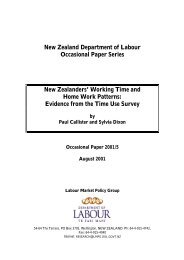

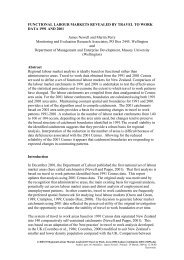

![a note on levels, trends, and some implications [pdf 21 pages, 139KB]](https://img.yumpu.com/27285836/1/184x260/a-note-on-levels-trends-and-some-implications-pdf-21-pages-139kb.jpg?quality=85)


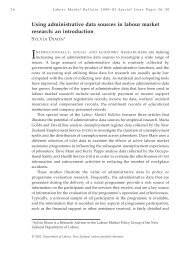
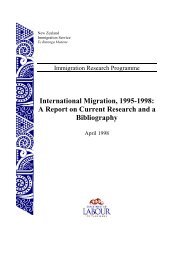

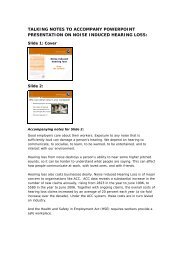
![Labour Market Trends and Outlook - 1996 [pdf 18 pages, 94KB]](https://img.yumpu.com/27285764/1/184x260/labour-market-trends-and-outlook-1996-pdf-18-pages-94kb.jpg?quality=85)

